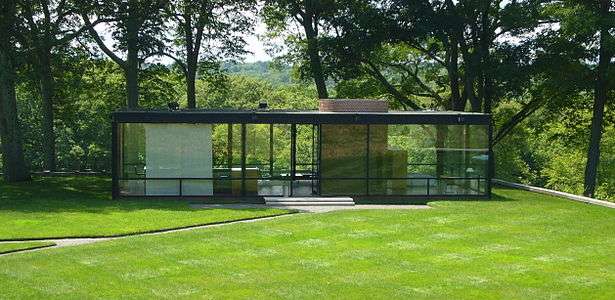Urban Glass House
| Urban Glass House | |
|---|---|
 Philip Johnson's Urban Glass House | |
| General information | |
| Type | Mixed use |
| Architectural style | Modern |
| Location |
330 Spring Street Manhattan New York City |
| Country | United States |
| Construction started | 2005 |
| Completed | 2006 |
| Height | 137 ft (41.76 m) |
| Technical details | |
| Floor count | 12 |
| Design and construction | |
| Architect |
Philip Johnson SLCE Architects |
| References | |
| [1] | |
Urban Glass House is a condominium building designed by American architect Philip Johnson located in the SoHo neighborhood of New York City.[2][3] It was Johnson's final project; he did not live to see construction finished.[4] The building's name is a reference to Johnson's earlier Glass House, located in New Canaan, Connecticut, although the Urban building bears little resemblance to the original.[5] The interiors were designed by Annabelle Selldorf, an American designer and architect.
The building saw a downturn in sales after the construction of a garage across the street from the development was announced.
Development

The building was initially to be developed by restauranter and developer Antonio Vendome. Vendome commissioned Johnson to create a building of multi-colored bricks which, unlike the current design, eschewed right angles and was asymmetrical, atypical for Johnson.[4] This plan was referred to as a "living sculpture". The original plans also called for a significantly taller building, at twenty stories high.[4] Due to zoning restrictions, this plan was abandoned. During development, Vendome withdrew from the project, selling his stake to three other developers: Charles Blaichman, Scott Sabbagh, and Abram Shnay. The three asked Johnson to draw from his past designs, including the Seagram Building, to inform the plans for the structure.[4] After Alan Ritchie, Johnson's architectural partner, suggested an homage to Johnson's original Glass House, plans were changed to reflect that idea. After the redesign, SLCE Architects was brought in to refine and complete the structure due to Johnson's impending retirement, and, ultimately, his death.[4]
Annabel Selldorf, responsible for the building's interiors, also drew inspiration from the original Glass House. She incorporated, for example, herringbone floors similar to those in the Johnson house, albeit made of white oak, rather than brick.[6]
Sanitation Department controversy
Not long after the building began sales, the New York City Department of Sanitation announced the construction of a truck garage across the street, at 353 Spring, which sparked controversy and a downturn in sales.[7][8][9] The space was originally occupied by a UPS lot and a smaller Department of Sanitation building.[6] During development, purchasers were made aware that a high rise or a garage could someday occupy the space.[7] The new structure drew ire due to worries that it would obscure views of the Hudson River for many of the residences in the building.[7]
Efforts to prevent the structure's construction failed, despite support from celebrities including James Gandolfini, Lou Reed, John Slattery, and Michael Stipe.[6][10] A garage designed by Dattner Architects was eventually erected on the site; later, a salt storage shed, also designed by Dattner, was built as well.[11][12] The two new structures, after completion, received with praise as "[one] of the best examples of new public architecture in the city" and "a boon to the neighborhood".[6][10]
Usage and residents
The building is primarily residential, with forty apartments.[2] Amenities include bicycle storage and an in house fitness facility.[2] There is also ground level retail and a restaurant, which belongs to Antonio Vendome, the original developer of the property.
Marina Abramović lived in the building until 2014.[13][14] Sol Kerzner has also owned a residence in the building.[15]
See also
References
- ↑ "The Urban Glass House". Emporis. Retrieved 12 March 2017.
- 1 2 3 "Urban Glass House 330 Spring Street". The New York Times. Retrieved 27 January 2016.
- ↑ Robledo, Johanna (4 July 2010). "Garbage In, Garbage Out". New York Magazine. Retrieved 27 January 2016.
- 1 2 3 4 5 "History Lives in Glass Houses". Bloomberg. 14 November 2005. Retrieved 27 January 2016.
- ↑ Bernstein, Fred (25 September 2005). "A Stone's Throw Away From the Other House". The New York Times. Retrieved 28 January 2016.
- 1 2 3 4 Michael, Kimmelman (21 December 2015). "For New York's Best New Public Sculpture, Thank the Sanitation Department". The New York Times. Retrieved 28 January 2016.
- 1 2 3 Barbanel, Josh (28 January 2007). "Few Views Are Forever". The New York Times. Retrieved 28 January 2016.
- ↑ Arak, Joey (6 July 2010). "Urban Glass House Brokers Embrace the Tower o' Garbage!". Curbed. Retrieved 28 January 2016.
- ↑ Amato, Rowley (9 February 2014). "Crazy Salt Shed to Rise Soon in Tribeca". Curbed. Retrieved 28 January 2016.
- 1 2 Davidson, Justin (22 December 2015). "A High-Style Garbage Garage on West Street". New York Magazine. Retrieved 30 January 2016.
- ↑ Arak, Joey (11 May 2010). "Tower O' Garbage Victorious in Epic Hudson Square Battle". Curbed. Retrieved 28 January 2016.
- ↑ Warerkar, Tanay (22 January 2016). "NYC's New Salt Shed Is a Functional Piece of Architectural Eye Candy". Curbed. Retrieved 28 January 2016.
- ↑ Budin, Jeremiah (17 April 2013). "Marina Abramovic Buys a $2.65 Million Apartment in Soho". Curbed. Retrieved 27 January 2016.
- ↑ Budin, Jeremiah (6 August 2014). "Marina Abramovic Already Done With Soho Condo, Gets $3M". Curbed. Retrieved 27 January 2016.
- ↑ Neuman, William (26 March 2006). "After the Lights and the Action". The New York Times. Retrieved 28 January 2016.
Coordinates: 40°43′33″N 74°00′35″W / 40.725768°N 74.009676°W